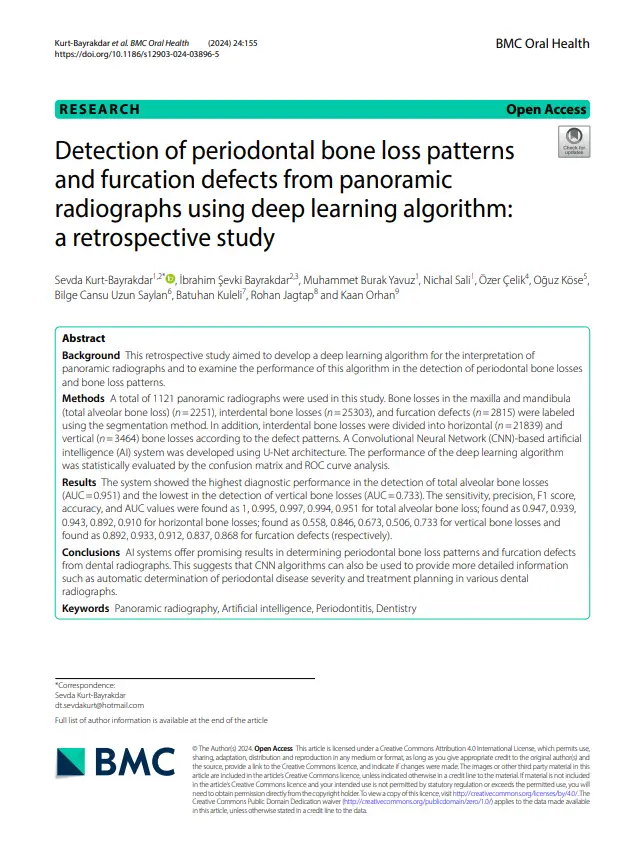Automatic Detection and Classification of Dental Restorations in Panoramic Radiographs with Artificial Intelligence Method Developed Using Deep Learning Method: Methodological Studies
The aim of this study is to automatically detect and classify dental restorations in panoramic radiographs using a deep learning-based artificial intelligence (AI) method.
Materials and Methods
Data Preparation
- Data Set: A total of 789 panoramic radiographs from children aged 12-15 years were used. The radiographs were obtained from the radiology archive of Atatürk University Faculty of Dentistry.
- Grouping: Panoramic radiographs were divided into two groups: fillings and root canal treatments.
- Model: The U-Net model, implemented with the PyTorch library, was used. This model was used for the detection and segmentation of restorative materials.
Evaluation of Artificial Intelligence Performance
Evaluation Using Confusion Matrix
- Filling Group: Out of 94 labeled teeth with fillings in 50 images, 89 were true positives, 1 was a false positive, and 4 were false negatives. The sensitivity, precision, and F1 scores were 0.9569, 0.9888, and 0.9726, respectively.
- Root Canal Treatment Group: Out of 76 labeled teeth with root canal treatments in 40 images, 60 were true positives, 0 false positives, and 11 false negatives. The sensitivity, precision, and F1 scores were 0.8450, 1, and 0.9160, respectively.
Results and Discussion
Performance of Deep Learning-Based Artificial Intelligence Models
Deep learning-based AI models performed very well in the automatic detection of restorations in panoramic radiographs obtained from children in the permanent dentition period. AI tools can save clinicians time and assist as a decision support system.
Statistical Analysis
Methods Used to Evaluate Model Performance
A confusion matrix was used to evaluate model performance. This matrix is a table commonly used to describe the performance of a classification model on a set of test data for which the true values are known.
Clinical Relevance of the Study
Use of Artificial Intelligence Applications in Dentistry
Dental clinical applications are open to the innovations brought by technology. The adaptation of AI can be applied in many areas such as caries detection, pre-orthodontic treatment planning, implant planning, and diagnosis of pathologies observed in the jaws. Especially the compatibility of AI with image processing highlights the studies conducted on radiology.
Data Set and Model Training
Detailing the Data Set and Model Training
- Data Set: The study was approved by the Clinical Research Ethics Committee of Atatürk University. The data set was divided into two groups: dental restorations with fillings and root canal treatments.
- Model Training: The model training was performed on a computer with 16 GB RAM and an NVIDIA GeForce GTX 1060Ti graphics card. Before training, each panoramic radiograph was resized from 2,943x1,435 pixels to 1,024x512 pixels.
I Want to Write a Scientific Research Project
CranioCatch is a global leader in dental medical technology that improves oral care in the field of dentistry. With AI-supported clinical, educational, and labeling solutions, we provide significant improvements in the diagnosis and treatment of dental diseases using contemporary approaches in advanced machine learning technology.
CranioCatch serves thousands of patients with dental health issues worldwide every day with its innovative technologies. That’s why we eagerly look forward to meeting our valued dentists who wish to work in the field of 'Scientific Research in Dentistry'.



 Contact Us
Contact Us

